เป็นที่ประจักษ์แล้วว่าแบตเตอร์รี่ไอออน Li-ion (polymer) และ แบตเตอร์รี่ ลิเทียมโคบอลล์ออกไซด์ (LiCoO2) มีการใช้งานอย่างมากในอุตสาหกรรมอิเลกทรอนิกส์ แต่แบตเตอร์รี่ลิเทียมโคบอลล์ออกไซด์ (LiCoO2) ราคาแพงมาก และไม่ปลอดภัยเมื่อมันมีความจุสูงขึ้น แบตเตอร์รี่ลิเทียมไอออนฟอสเฟต (LiFePo4) เป็นตัวเลือกที่ดีที่สุดในปัจจุบันนี้ ตลาดแบตเตอร์รี่ตระกูลลิเทียมไอออนมีความนิยมเนื่องจากมีความจุสูงและสามารถ นำไปใช้งานได้หลากหลาย เช่น คอมพิวเตอร์แลบทอป เครื่องมือกล รถวีลแชร์ไฟฟ้า รถจักรยานไฟฟ้า รถไฟฟ้า แม้นแต่รถบัสไฟฟ้า แบตเตอร์รี่ลิเทียมไอออนฟอสเฟต (LiFePo4) มีความปลอดภัยเทียบเท่าแบตเตอร์รี่แบบตะกั่วกรด แต่ความแรงเทียบเท่าแบตแบบตระกูลลิเทียมไอออน ข้อดีของลิเทียมไอออน Li-ion (polymer) ที่เป็นชนิดลิเทียมไอออนฟอสเฟต (LiFePo4)คือ
1. ชาร์จไว
ใน ระหว่างกระบวนการชาร์จแบตเตอร์รี่ Li-ion แบบดั้งเดิมประกอบด้วย ลิเทียมโคบอลต์ออกไซต์(LiCoO2) ต้องการชาร์จสองขั้นตอน ขั้นตอนแรก คือการใช้กระแสคงที่ (Constant Current:CC) เพื่อให้ถึง 60% ของจุดชาร์จ (Stage of Charge:SOC) ขั้นตอนที่สอง เกิดขึ้นเมื่อแรงดันไปถึง 4.2V เป็นขีดจำกัดบนแรงดันของการชาร์จ ก็จะเริ่มชาร์จที่แรงดันคงที่จนกว่ากระแสจะลดลงเรื่อยๆ ในขั้นตอนที่ (60%SOC) ใช้เวลาประมาณ 2 ชั่วโมง และในขั้นตอนที่ 2 (40%SOC) ใช้เวลาอีกประมาณ 2 ชั่วโมง แต่แบตเตอร์รี่ LiFePo4 สามารถใช้แค่ 1 ขั้นตอน เมื่อ CC ไปถึง 95% ของ SOC หรืออาจชาร์จทั้ง CC+CV เพื่อให้ถึง 100%SOC เวลาทั้งหมดประมาณสองชั่วโมง
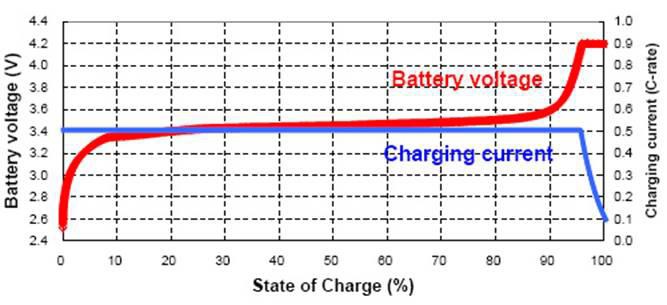
แรงดันและกระแสในการชาร์จ
2. มีการเผื่อต่อการชาร์จมากไป (over charge) สูง และสมรรถนะที่ปลอดภัยกว่า
แบ ตเตอร์รี่ LiCoO2 มีการเผื่อต่อการโอเวอร์ชาร์จแคบมาก ประมาณ 0.1V ที่แรงดันชาร์จ 4.2V และต้องพิจารณาขีดจำกัดควบคุมบนของการชาร์จแรงดันด้วย ถ้าชาร์จเกิด 4.3V อาจทำให้แบตเตอร์รี่ประสิทธิภาพตกได้และอาจเป็นเหตุให้ไฟไหม้และระเบิดได้ แบตเตอร์รี่ LiFePO4 มีการผื่อต่อการโอเวอร์ชาร์จกว้างมากกว่าเป็น 0.7V ที่แรงดันชาร์จเป็น 3.4V
ความร้อนจากปฏิกิริยาเคมีวัดจาก DSC หลังจากโอเวอร์ชาร์จเป็น 90J/g สำหรับ LiFePO4 และ 1600J/g for LiCoO2 ยิ่งมีการคายความร้อนมากเท่าไร จะเกิดพลังงานจะสะสมในแบตเตอร์รี่ในทางสิ้นเปลืองและอาจทำให้ไฟไหม้และ ระเบิดได้ แต่แบตเตอร์รี่ LiFePo4 สามารถโอเวอร์ชาร์จได้ถึง 30V โดยไม่ต้องมีวงจรป้องกัน เหมาะสมกับการใช้งานที่กระแสสูงๆ ความจุสูงๆ ในรูปแสดงถึงความปลอดภัยและความทนต่อการโอเวอร์ชาร์จของแบตเตอร์รี่ LiFePO4 กราฟมีลักษณะคล้ายการตอบสนองของแบตเตอร์รี่ตะกั่วกรด
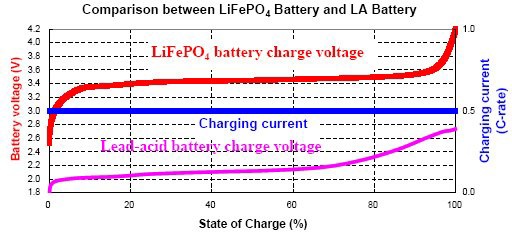
เปรียบเทียบ แบตเตอร์รี่ LiFePo4 และแบตเตอร์รี่แบบตะกั่วกรด
3. สมดุลด้วยตัวเอง
เซลของ LiFePO4 จะถูกต่ออนุกรมและจัดให้สมดุลระหว่างกระบวนการชาร์จ เนื่องจากมีความเผื่อต่อการโอเวอร์ชาร์จสูง นี่คือข้อแตกต่างจากแบตเตอร์รี่แบบตะกั่วกรด คุณลักษณะการสมดุลย์ตัวเองสามารถยอมให้ความแตกต่างระหว่างเซลสำหรับทั้งแรง ดันและความจุของแบตเตอร์รี่ไม่เกิน 10% ดังรูปด้านล่าง
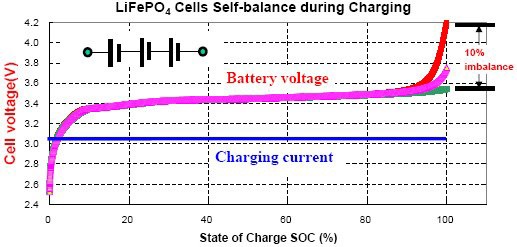
การสมดุลย์แรงดันแต่ละเซลให้แตกต่างไม่เกิน 10%
4. ระบบจัดการแบตเตอร์รี่ (Battery Management System) และ แบตเตอร์รี่ชาร์จเจอร์ง่ายกว่า
การ เผื่อโอเวอร์ชาร์จและชุดสมดุลของแบตเตอร์รี่ LiFePo4 ส่วนมากจะมีชุดป้องกันแบตเตอร์รี่และวงจรที่มีราคาไม่แพง ใช้การชาร์จเพียงหนึ่งขั้นตอน อาจใช้แหล่งจ่ายไฟแบบทั่วไปเพื่อชาร์จแบตเตอร์รี่ LiFePO4 แทนที่จะเป็นชาร์จเจอร์แบบ Li-ion
5. อายุการใช้งานที่ยืนยาว
เมื่อ เปรียบเทียบอายุการใช้งานของแบตเตอร์รี่ LiCoO2 มีอายุการชาร์จเพียง 400 ครั้ง แต่ แบตเตอร์รี่ LiFePO4 อายุการชาร์จถึง 2000 ครั้ง
6. สมรรถนะอุณหภูมิสูง
ข้อเสียของการแบตเตอร์รี่ LiCoO2 คือประสิทธิภาพจะลดลงเมื่ออุณหภูมิสูงขึ้นจนถึง 60C แบตเตอร์รี่ LiFePO4 ทำงานได้ดีกว่า ที่อุณหภูมิสูงขึ้น เนื่องจากการนำความร้อนของลิเทียมไอออนนิกที่สูงกว่า
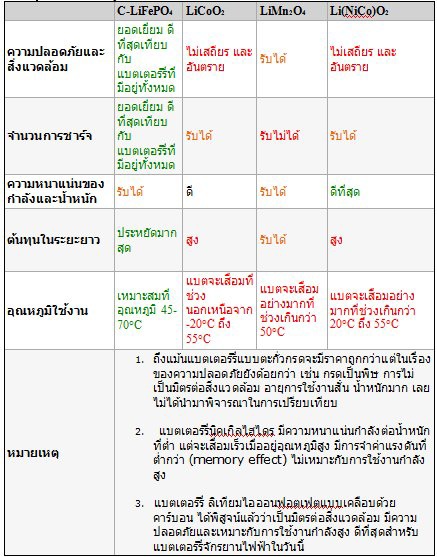

ตารางเปรียบเทียบแบตเตอร์รี่ชนิดต่างๆ
ขอขอบคุณและอ้างอิงแหล่งที่มา : http://blog.ebikr.com
ต้วอย่างข้อมูลของแบตเตอรี่แต่ละ cell (3.2V10AH : 38120S)
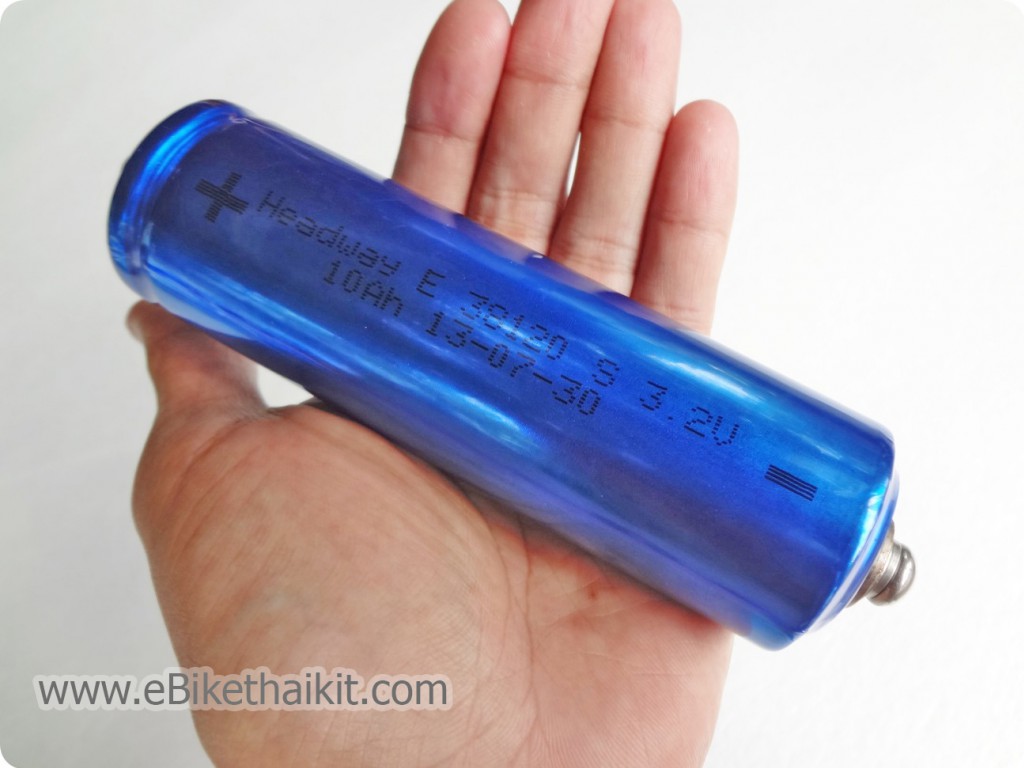
| NO. | ITEM | Specifications | |
| 3-1 | Nominal Capacity: | 10000mAh | |
| 3-2 | Rated voltage | 3.2V | |
| 3-3 | Energy density (Wh/kg) | 105 | |
| 3-4 | Internal Resistance | ≤4mΩ | |
| 3-5 | Charge (CC-CV) | Charged with constant current to 3.65v and then charged with constant voltage to 0.1-0.2A | |
| 3-6 | Charge (float) | ≤3.6V | |
| 3-7 | Max. charging current | 3C(30A) | |
| 3-8 | Standard. charging voltage | 3.65±0.05V | |
| 3-9 | Recommended charging current | 0.5C, 5A ×2hours | |
| 3-10 | Max. continuous discharging current | 3C (30A)-10C(100A) | |
| 3-11 | Max.pulse discharging current(30seconds) | 15C(150A) | |
| Recommended discharging current | 1C(10A) | ||
| 3-12 | Max. End-off discharged voltage | 2.0V | |
| 3-13 | Self discharge rate (monthly) | 2-3% | |
| 3-14 | Dimensions (mm) | Diameter | 38±1 |
| Height | 38120L:122±1; 38120S:132±1 | ||
| 3-15 | Weight (Approx.) | 38120L:300g; 38120S: 330g | |
| 3-16 |
Working temperature |
Charging | 0~45℃ |
| Discharging | -20~65℃ | ||
| 3-17 | Storage temperature |
In one month | -20~45℃ |
| In six months | -20~35℃ | ||
How to charge Lithium Iron Phosphate Rechargeable Lithium Ion Batteries
Lithium Iron phosphate batteries are safer than Lithium-ion cells, and are available in a range of cell sizes between 5 and 100 AH with much longer cycle life than conventional batteries.
Lithium iron phosphate is a type of lithium-ion battery, since the energy is stored in the same way, moving and storing lithium ions instead of lithium metal. These cells and batteries not only have high capacity, but can deliver high power. High-power lithium iron phosphate batteries are now a reality. They can be used as storage cells or power sources.
In addition, Lithium Iron Phosphate batteries are among the longest lived batteries ever developed. Test data in the laboratory show up to 2000 charge/discharge cycles. This is due to the extremely robust crystal structure of the iron phosphate, which does not break down under repeated packing and unpacking of the lithium ions during charging and discharging
| Lithium Iron Phosphate Parameters | ||
| Nominal voltage | 3.2 Volts | |
| Peak voltage | 3.65 Volts | |
| Absolute Minimum discharge voltage | 2.0 Volts | |
| CV charge voltage | 3.65 Volts | |
| CV charge voltage | 3.5 Volts | |
| Charge Temperature | 0°-40°C | 100% charge |
| Discharge Temperature | -10°-60°C | 95% charge |
LiFePO4 Battery Charging
Innovation in Li-ion Battery:
LiFePO 4 Power Battery, Faster charging and safer performance
Although small capacity Li-ion (polymer) Battery containing lithium cobalt oxide (LiCoO 2) offers a the best mass energy density and volume energy density available, lithium cobalt oxide (LiCoO2) is very expensive and unsafe for large scale Li-ion Batteries.
Recently lithium iron phosphate (LiFePO4) has been becoming the "best-choice" of materials in commercial Li-ion (and polymer) batteries for large capacity and high power applications, such as laptops, power tools, wheel chairs, e-bikes, e-cars and e-buses.
The LiFePO4 battery has hybrid characters: it is as safe as the lead-acid battery and as powerful as the lithium ion battery. The advantages of large format Li-ion (and polymer) batteries containing lithium iron phosphate (LiFePO4) are listed as below:
1. Conventional charging
During the conventional lithium ion charging process, a conventional Li-ion Battery containing lithium iron phosphate (LiFePO4) needs two steps to be fully charged: step 1 uses constant current (CC) to reach about 60% State of Charge (SOC); step 2 takes place when charge voltage reaches 3.65V per cell, which is the upper limit of effective charging voltage. Turning from constant current (CC) to constant voltage (CV) means that the charge current is limited by what the battery will accept at that voltage, so the charging current tapers down asymptotically, just as a capacitor charged through a resistor will reach the final voltage asymptotically.
To put a clock to the process, step 1 (60%SOC) needs about one hour and the step 2 (40%SOC) needs another two hours.
1. Fast "forced" charging:
Because an overvoltage can be applied to the LiFePO4 battery without decomposing the electrolyte, it can be charged by only one step of CC to reach 95%SOC or be charged by CC+CV to get 100%SOC. This is similar to the way lead acid batteries are safely force charged. The minimum total charging time will be about two hours.

2. Large overcharge tolerance and safer performance
A LiCoO2 battery has a very narrow overcharge tolerance, about 0.1V over the 4.2V per cell charging voltage plateau, which also the upper limit of the charge voltage. Continuous charging over 4.3V would either damage the battery performance, such as cycle life, or result in fire or explosion.
A LiFePO4 battery has a much wider overcharge tolerance of about 0.7V from its charging voltage plateau of 3.5V per cell. When measured with a differential scanning calorimeter (DSC) the exothermic heat of the chemical reaction with electrolyte after overcharge is only 90 Joules/gram for LiFePO4 versus 1600 J/g for LiCoO2 . The greater the exothermic heat, the more vigorous the fire or explosion that can happen when the battery is abused.
A LiFePO4 battery can be safely overcharged to 4.2 volts per cell, but higher voltages will start to break down the organic electrolytes. Nevertheless, it is common to charge a 12 volt a 4-cell series pack with a lead acid battery charger. The maximum voltage of these chargers, whether AC powered, or using a car's alternator, is 14.4 volts. This works fine, but lead acid chargers will lower their voltage to 13.8 volts for the float charge, and so will usually terminate before the LiFe pack is at 100%. For this reason a special LiFe charger is required to reliably get to 100% capacity.
Due to the added safety factor, these packs are preferred for large capacity and high power applications. From the viewpoint of large overcharge tolerance and safety performance, a LiFePO4 battery is similar to a lead-acid battery.
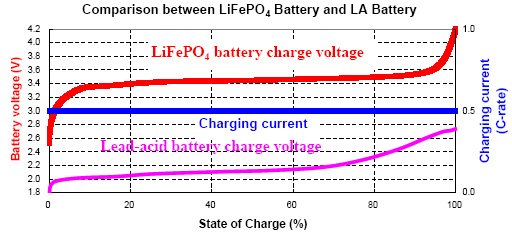
3. Self balance
Unlike the lead-acid battery, a number of LiFePO4 cells in a battery pack in series connection cannot balance each other during charging process. This is because the charge current stops flowing when the cell is full. This is why the LiFEPO4 packs need management boards.
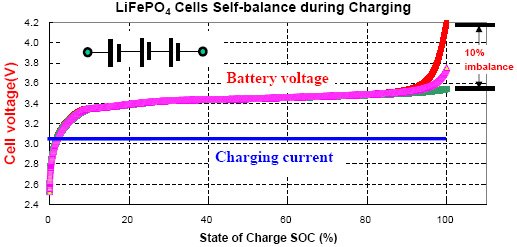
4. Four times higher energy density than Lead-acid battery
Lead-acid battery is an aqueous system. The single cell voltage is nominally 2V during discharge. Lead is a heavy metal, its specific capacity is only 44Ah/kg. In comparison, the lithium iron phosphate (LiFePO4) cell is a non-aqueous system, having 3.2V as its nominal voltage during discharge. Its specific capacity is more than 145Ah/kg. Therefore, the gravimetric energy density of LiFePO4 battery is 130Wh/kg, four times higher than that of Lead-acid battery, 35Wh/kg.
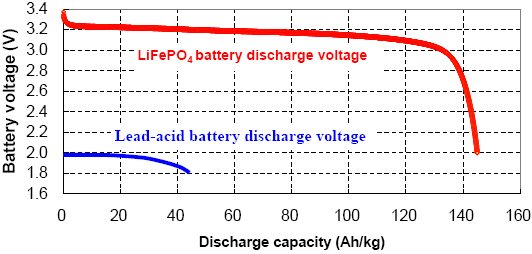
5. Simplified battery management system and battery charger
Large overcharge tolerance and self-balance characteristic of LiFePO4 battery can simplify the battery protection and balance circuit boards, lowering their cost. The one step charging process allows the use of a simpler conventional power supplier to charge LiFePO4 battery instead of using an expensive professional Li-ion battery charger.
6. Longer cycle life
In comparison with LiCoO2 battery which has a cycle life of 400 cycles, LiFePO4 battery extends its cycle life up to 2000 cycles.
7. High temperature performance
It is detrimental to have a LiCoO2 battery working at elevated temperature, such as 60°C. However, a LiFePO4 battery runs better at elevated temperature, offering 10% more capacity, due to higher lithium ionic conductivity.








